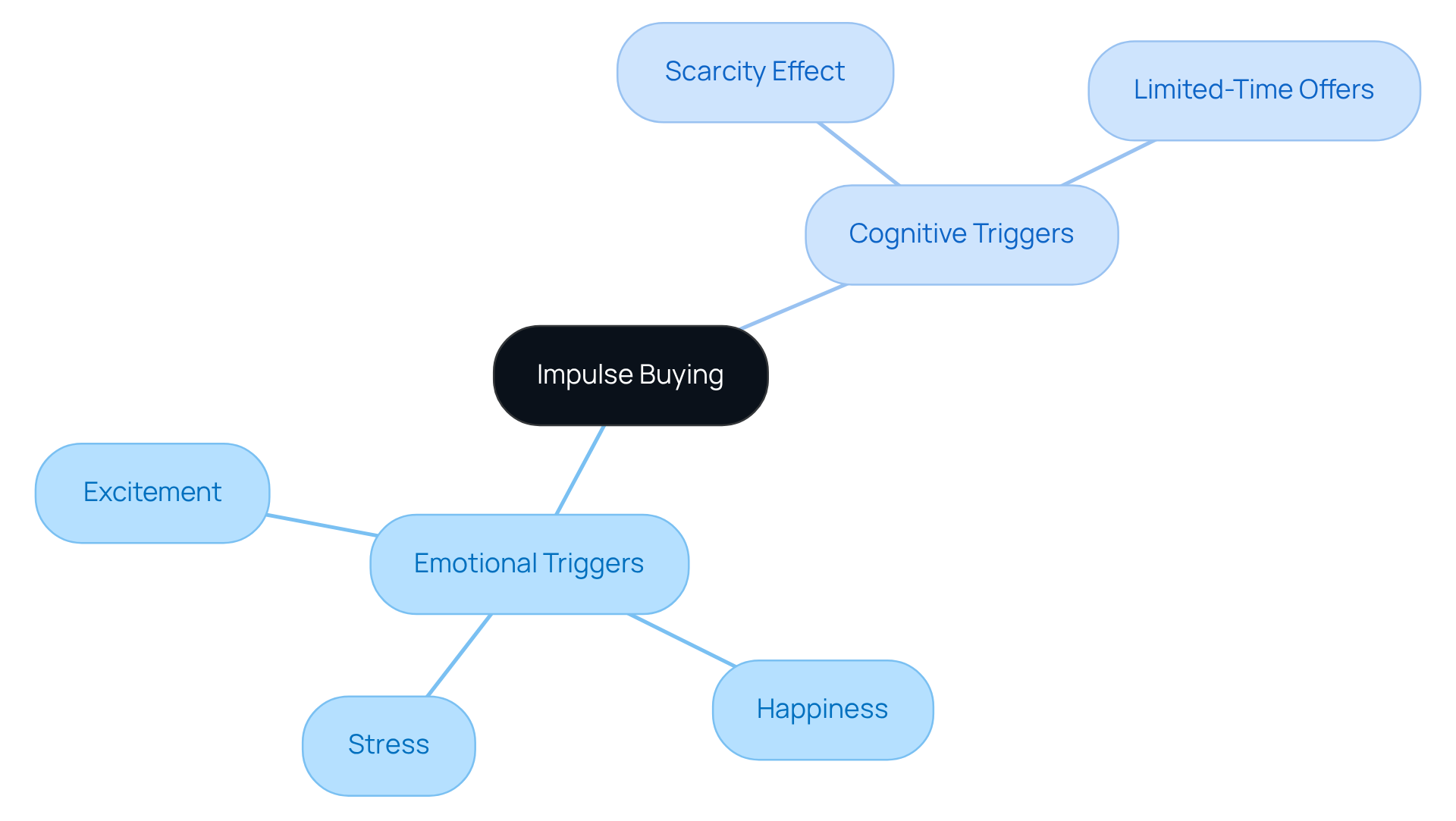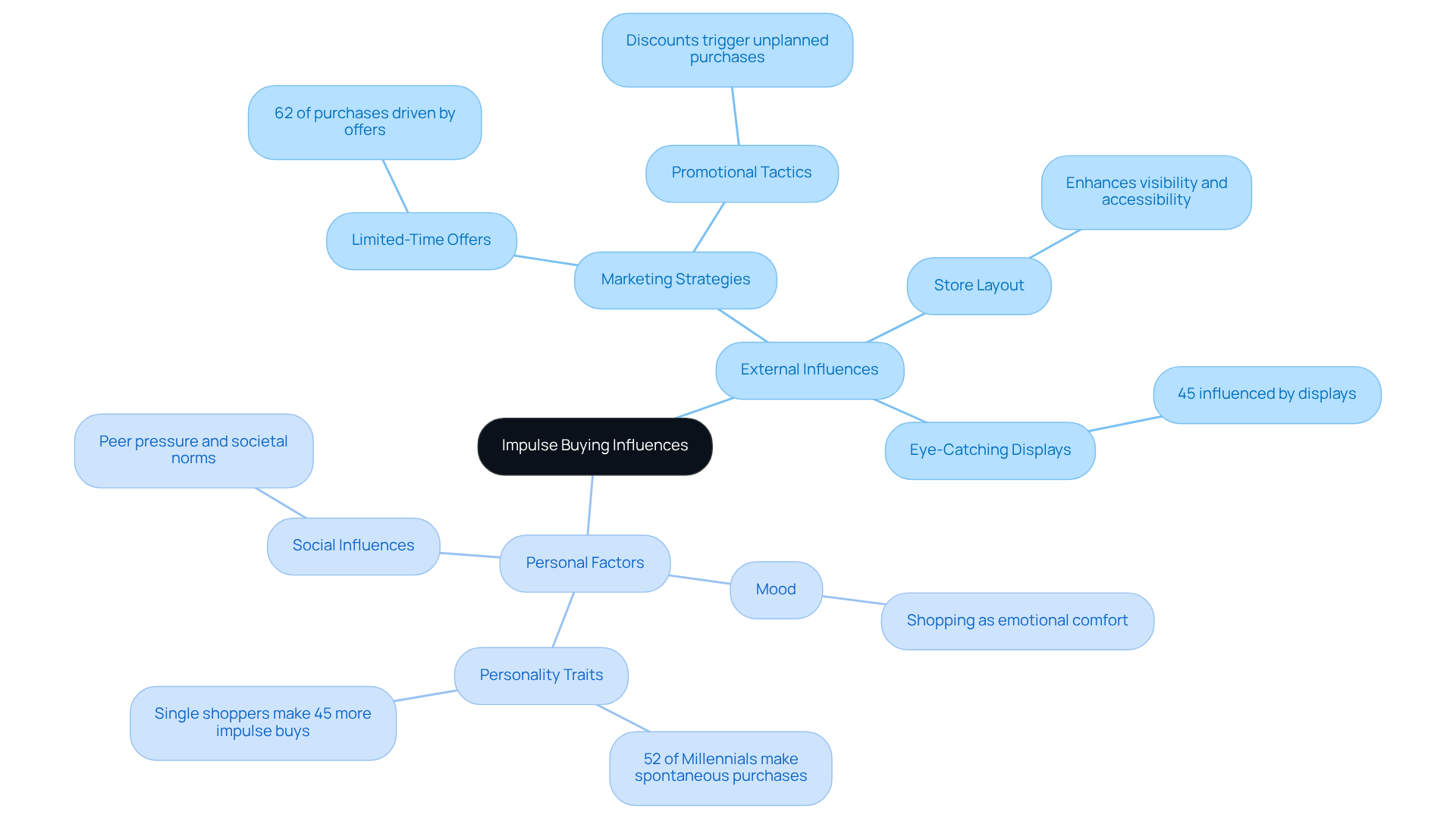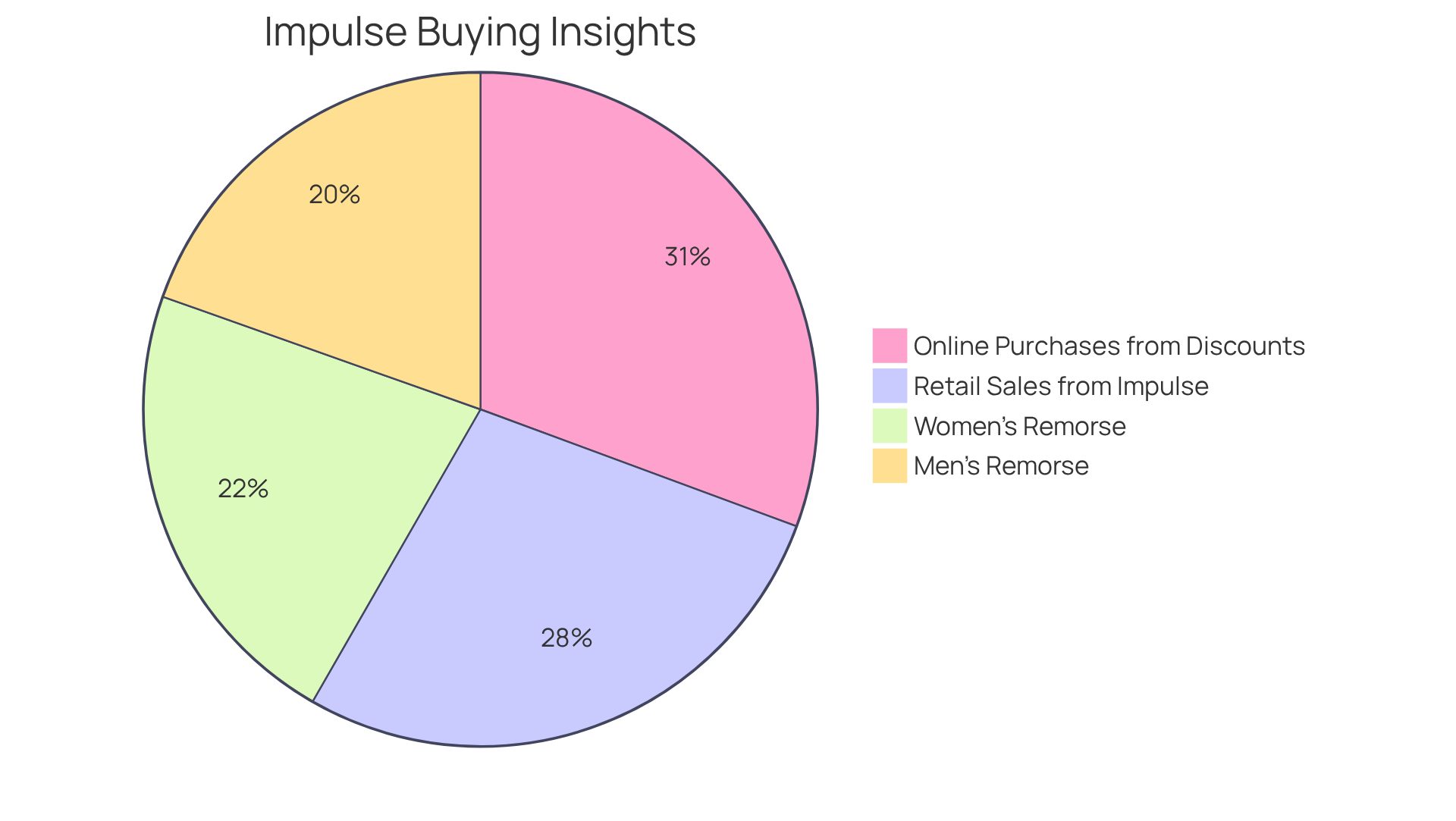
Overview
Impulse buying is a phenomenon defined by spontaneous, unplanned purchases that are driven by emotional reactions rather than logical decision-making. This behavior significantly impacts consumer behavior and retail profitability. Notably, impulse purchases account for 60-70% of retail sales, showcasing their prevalence and importance.
These purchases are often influenced by external factors, including:
- Marketing strategies
- Emotional triggers
Thus, understanding impulse buying is crucial for businesses aiming to optimize their marketing approaches. By doing so, they can effectively boost sales while also navigating the potential pitfalls of buyer's remorse.
Introduction
Impulse buying stands as a pivotal phenomenon within the retail landscape, characterized by spontaneous purchases often propelled by emotional impulses rather than rational deliberation. This behavior not only unveils the psychological intricacies of consumer decision-making but also bears significant implications for individual spending habits and broader market trends.
As shoppers traverse enticing displays and promotional strategies, a critical question emerges: what factors genuinely drive these unplanned acquisitions? Furthermore, how can businesses adeptly leverage this behavior to bolster profitability while preserving customer satisfaction?
Delving into the causes and consequences of impulse buying reveals a complex interplay of emotional triggers, cognitive biases, and external influences that shape consumer behavior in today's dynamic marketplace.
Define Impulse Buying: Key Characteristics and Examples
What is impulse buying? It is characterized by unplanned acquisitions driven by emotional reactions rather than logical decision-making. This behavior, often associated with what is impulse buying, is distinguished by spontaneity, a lack of forethought, and heightened emotional arousal. For instance, a shopper may impulsively purchase a pair of shoes on sale while browsing, despite not intending to buy anything that day. Such behavior is particularly prevalent in retail environments, where items are strategically positioned to capture interest, leading to impulsive purchasing choices, which exemplify what is impulse buying and can significantly boost sales figures.
Statistics reveal that approximately 84% of consumers have made unplanned purchases, which account for nearly 40% of all e-commerce spending. Notably, individual shoppers are 45% more likely to engage in behaviors that exemplify what is impulse buying compared to their married counterparts, indicating distinct patterns of consumer behavior. Furthermore, 54% of U.S. shoppers have spent $100 or more on what is impulse buying, highlighting the significant financial implications of this behavior. On average, customers make three spontaneous acquisitions during 40% of their store visits, which exemplifies what is impulse buying and the prevalence of impulsive spending behaviors.
Successful direct-to-consumer (DTC) companies capitalize on these insights by and product placements to encourage what is impulse buying. For example, crafting visually appealing displays and offering limited-time promotions can effectively stimulate spontaneous purchases. Additionally, with 48% of social media users having impulsively purchased a product they first encountered on a social media feed, companies should consider integrating social media strategies into their marketing efforts. As the e-commerce landscape evolves, brands will need to understand what is impulse buying and the psychological factors behind spontaneous purchases to leverage this lucrative consumer behavior.

Explore the Psychology Behind Impulse Buying: Emotional and Cognitive Triggers
The psychology behind what is impulse buying is multifaceted, encompassing both emotional and cognitive triggers. Emotional triggers, such as excitement, happiness, or even stress, can propel consumers toward immediate gratification through purchases. Concurrently, cognitive biases, including the scarcity effect—where items are perceived as more valuable when in limited supply—significantly influence buying behavior.
For instance, a limited-time offer can instill a sense of urgency, compelling consumers to make impulsive purchases to avoid missing out. Understanding what is impulse buying allows companies to that resonate with consumers' emotional states, ultimately driving increased conversion rates.
By collaborating with Parah Group, DTC brand owners can leverage expert Conversion Rate Optimization strategies rooted in these psychological insights, ensuring that marketing initiatives not only capture attention but also convert interest into sustainable growth and profitability.

Identify Causes of Impulse Buying: External Influences and Personal Factors
What is , and how are impulse purchases significantly influenced by a complex interplay of external and personal factors? External influences—such as marketing strategies, store layout, and promotional tactics—are crucial in creating an enticing shopping environment. Attention-grabbing displays and time-sensitive discounts serve as important motivators; research indicates that 62% of spontaneous purchases are driven by such offers. Moreover, the layout of a store can enhance the visibility and accessibility of products, further encouraging spontaneous buying behavior. Notably, research reveals that 8 out of 10 spontaneous purchases occur in physical stores, underscoring the importance of effective in-store merchandising.
On the personal side, individual factors—including mood, personality traits, and social influences—significantly affect what is impulse buying. For instance, individuals experiencing stress may turn to shopping as a source of emotional comfort, highlighting what is impulse buying. Millennials, in particular, are especially susceptible to unplanned spending, leading many to wonder what is impulse buying, with 52% admitting to making spontaneous acquisitions. Furthermore, individual shoppers are likely to make 45% more spontaneous purchases compared to their married counterparts, suggesting that relationship status can influence spending habits.
Understanding these dynamics allows companies to adjust their marketing strategies to either leverage or mitigate spontaneous purchasing behaviors. For example, employing clear value propositions and benefits-driven messaging can resonate with consumers, particularly during high-stress periods. Additionally, optimizing product displays and ensuring fast loading times on mobile platforms can enhance the shopping experience, facilitating quicker decision-making. Ultimately, by utilizing both external and personal factors, businesses can develop more effective marketing strategies that encourage spontaneous buying.

Assess the Impact of Impulse Buying: Consumer Behavior and Brand Profitability
Impulse purchases significantly influence consumer behavior and company profitability. For businesses, these unplanned acquisitions can lead to increased sales and elevated average order values (AOV), ultimately enhancing overall profitability. Notably, impulse buying constitutes 60-70% of retail sales, underscoring that a substantial portion of consumer spending is driven by emotion rather than logic. Furthermore, 72% of online consumers engage in spontaneous purchases due to discounts, highlighting the emotional triggers that companies can strategically harness. However, while these acquisitions may boost short-term revenue, they can also result in buyer's remorse, negatively impacting long-term customer loyalty. For instance, 46% of men and 52% of women report feelings of remorse over spontaneous purchases, with 39% of these decisions influenced by others' actions, indicating that companies must navigate this delicate balance with care.
Brands that effectively leverage spontaneous spending can create a positive feedback loop, wherein satisfied customers are more likely to return for additional acquisitions. Direct-to-consumer (DTC) companies that implement tailored suggestions based on past purchases can effectively encourage repeat spontaneous buying, thereby increasing customer lifetime value. In 2024, the average monthly spending reached $281.75, totaling over $3,000 annually, which highlights the opportunity for companies to capitalize on this behavior. Additionally, individual shoppers make 45% more spontaneous purchases compared to their married counterparts, suggesting a demographic insight that companies can target. Understanding what is is essential for brands seeking to optimize their conversion strategies and cultivate enduring consumer relationships.

Conclusion
Impulse buying stands as a significant consumer behavior, characterized by spontaneous, unplanned purchases driven more by emotions than by logical reasoning. This article has explored the multifaceted nature of impulse buying, underscoring its vital role in retail environments and the psychological triggers propelling consumers toward these impulsive decisions. For businesses seeking to optimize their marketing strategies and enhance consumer engagement, understanding the dynamics of impulse buying is indispensable.
Key insights reveal that impulse purchases constitute a substantial portion of retail sales, with emotional and cognitive factors serving as pivotal influences on consumer behavior. External elements, such as marketing strategies and store layouts, combined with personal factors like mood and social influences, foster an environment conducive to spontaneous buying. While impulse buying can yield immediate financial gains for businesses, it also presents risks, including buyer's remorse, which can undermine long-term customer loyalty.
Ultimately, recognizing the causes and impacts of impulse buying is essential for brands aiming to effectively harness this consumer behavior. By leveraging insights into emotional triggers and refining marketing strategies, companies can not only boost sales but also cultivate enduring relationships with their customers. Engaging with the psychology behind impulse buying paves the way for more thoughtful marketing approaches that resonate with consumers, contributing to sustainable growth in an increasingly competitive market.
Frequently Asked Questions
What is impulse buying?
Impulse buying refers to unplanned purchases driven by emotional reactions rather than logical decision-making, characterized by spontaneity, a lack of forethought, and heightened emotional arousal.
What are some examples of impulse buying?
An example of impulse buying is a shopper purchasing a pair of shoes on sale while browsing, despite not intending to buy anything that day.
How prevalent is impulse buying among consumers?
Approximately 84% of consumers have made unplanned purchases, which account for nearly 40% of all e-commerce spending.
Are there differences in impulse buying behavior between single and married individuals?
Yes, individual shoppers are 45% more likely to engage in impulse buying behaviors compared to their married counterparts.
What is the financial impact of impulse buying?
54% of U.S. shoppers have spent $100 or more on impulse purchases, indicating significant financial implications of this behavior.
How often do customers engage in impulse buying during store visits?
On average, customers make three spontaneous acquisitions during 40% of their store visits.
How do companies optimize for impulse buying?
Successful direct-to-consumer (DTC) companies optimize in-store experiences and product placements, craft visually appealing displays, and offer limited-time promotions to encourage impulse buying.
What role does social media play in impulse buying?
48% of social media users have impulsively purchased a product they first encountered on a social media feed, suggesting that companies should integrate social media strategies into their marketing efforts.
FAQs











